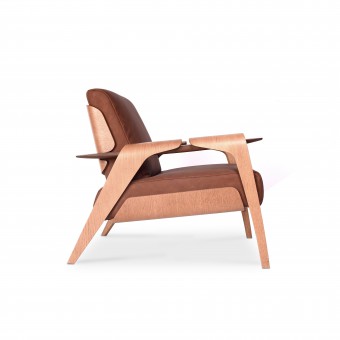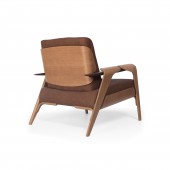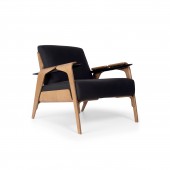
| THE AWARD |
| CATEGORIES |
| REGISTRATION |
| SUBMIT YOUR WORK |
| ENTRY INSTRUCTIONS |
| TERMS & CONDITIONS |
| PUBLICATIONS |
| DATES & FEES |
| METHODOLOGY |
| CONTACT |
| WINNERS |
| PRESS ROOM |
| GET INVOLVED |
| DESIGN PRIZE |
| DESIGN STORE |
| THE AWARD | JURY | CATEGORIES | REGISTRATION | PRESS | WINNERS | PUBLICATIONS | ENTRY INSTRUCTIONS |
Fly Armchair by Pepê Lima |
Home > Winners > Design #131645 >Interview |
 |
|
FS: What is the main principle, idea and inspiration behind your design?
PL: The central concept was to create a product that had its parts disconnected, but that was still able to maintain an idea of continuity. I studied at length the Deconstructive Style, and I was able to use layering and contrasts to show the texture of the wood as though the chair were dressed in armor. Even with the separate parts, I tried to maintain coherence within the radiuses and parallelism with the lines to have an idea of fluidity.
FS: What has been your main focus in designing this work? Especially what did you want to achieve?
PL: The goal was to propose something paradoxical, that is, to suggest continuity as well as fluidity between the elements that do not touch. Normally, fluid products with good continuity have their parts very well connected; organic as to appear to be in a liquid state. An example would be the arm of an armchair that leaves from the hind leg homogeneously, as though it were an extension of said leg. From there, I set myself the goal of exploring the idea of continuity from a different perspective.
FS: What are your future plans for this award winning design?
PL: The Fly armchair was launched in the second semester of 2021, and it has found a solid ground amongst clients and consumers. The acceptance of the product has been excellent, moreover; the myriad of finishing options opens a wide range of possibilities for customization. For that reason, I believe that we are talking about a product that will reach a great number of sales for a long while. Because of the grand possibility of customization, it is a product that people will likely not grow tired of quickly. We will keep it in line while sales remain satisfactory.
FS: How long did it take you to design this particular concept?
PL: The conceptual aspect of the chair didn’t take a lot of time to be developed. It took me about a week between having the idea and sketching the first concepts until the final 3D model. I showed the product to a partner company, and the project was approved, which caused me to spend another couple of days doing the technical detailing. The prototyping took me longer, something close to six months. It is a product that demanded techniques and solutions that were, until then, unknown to us.
FS: Why did you design this particular concept? Was this design commissioned or did you decide to pursuit an inspiration?
PL: I like to work with freedom. Usually, products that are hired don’t have the same degree of creativity as the products I make simply because I want to make them when I don’t have any restrictions to create. I am yet to understand the patterns that I use for my creations, or even if there is a pattern. I simply woke up in the mood to draw an armchair that looked as though it had exploded, but that still had a high degree of continuity. This way, things just happened.
FS: Is your design being produced or used by another company, or do you plan to sell or lease the production rights or do you intent to produce your work yourself?
PL: The Fly armchair is produced by a factory located in the city of São Bento do Sul, in the state of Santa Catarina, in Brazil. It has been produced and commercialized since the second semester of 2021.
FS: What made you design this particular type of work?
PL: I am a curious designer. I love challenging myself and going beyond my own expectations. I am constantly searching to draw something different and unheard of before. For a while now, my inspiration hasn't been something of the physical world like elements found in nature; my inspiration has been my own goals which I set out for myself for each product. In the case of the Fly armchair, my inspiration, my goal, was to create something that seemed as though it had exploded but at the same was continuous, like organized chaos.
FS: Where there any other designs and/or designers that helped the influence the design of your work?
PL: I’ve never stopped to think about it, but I’ve always admired the lines and products by Charles and Ray Eames. When one thinks about a plywood piece, it is impossible not to have Eames’ products in mind. With that said, I believe, one way or another, the Lounge Chair contributed to what the Fly armchair turned out to be.
FS: Who is the target customer for his design?
PL: It is a piece for a daring audience, one that keeps up with design tendencies, and who is constantly seeking cutting-edge products with a different style. Often, these types of clients have their houses as shrines to art, architecture, photography, and design, and they won’t hold back on their efforts to have pieces that add to their creative and unique decor. Usually, it is a group of people who belong to either the upper-middle or upper class, due to the price tag on the product, which is not usually very low.
FS: What sets this design apart from other similar or resembling concepts?
PL: Honestly, I have never seen anything like it. Maybe there is a product or concept that is similar, but none of which I am aware. With that said, I would only be able to compare the Fly armchair with other products from a wider perspective, for example, armchairs. Regarding the ones currently existing on the market, I believe that its construction, its different and daring lines, as well as its originality make it an outstanding armchair.
FS: How did you come up with the name for this design? What does it mean?
PL: I chose this name because depending on how the chair is configured along with the space into which the chair would be put, the parts would appear to struggle as if they weren’t connected to anything or anywhere. This thought was united with a comment from a friend who saw the project and asked me if it flew, for him, it seemed to be aerodynamic; hence, the name “Fly”.
FS: Which design tools did you use when you were working on this project?
PL: I always draw with a black pen in a checkered notebook. I think the pen is important because it cannot be erased, it helps to train confidence in my stroke; risked, there is no return. The squared paper helps me maintain proportions even in free sketches. In the computing part, software for 3D modeling and rendering and an image processing program. That's it, I'm a hands-on product designer.
FS: What is the most unique aspect of your design?
PL: I have a strong bias to talk about this, but I am completely in love with the lines and the ratios that compose the Fly armchair. When I saw the finished piece for the first time, I felt quite proud of myself, and I remember having the distinct thought that I had made a product with exceptional harmony among its shapes. So, I believe that that is its most unique feature.
FS: Who did you collaborate with for this design? Did you work with people with technical / specialized skills?
PL: My studio is one-man; here I am the one who does everything: I create, design, model and render in 3D, I propose to partner factories, prepare the technical drawings, monitor prototypes, take care of my social networks, website, etc. It's quite heavy but I prefer that way, being behind every stage. All my years of experience on the shop floor have allowed me to design things with the necessary knowledge of how they would be made in mind. However, the Fly armchair was a little more complex because I had never produced anything like it before. In this case, the talents of the prototypist from Móveis Jaime were essential to help me fill in certain gaps missing from the project.
FS: What is the role of technology in this particular design?
PL: It is a product whose details require precision. All the elements need to end in such a way that is perfect for its assembly; thus, more artisanal manufacturing wouldn’t be adequate for this product. We resorted to cutting-edge machinery to make all the cuts, holes, and bevels in the piece. Because it is an armchair that uses all its upholstery as a single structure, the wooden boxing had to be very well planned, which meant that a high level of precision would be necessary for the structure not to compromise comfort.
FS: Is your design influenced by data or analytical research in any way? What kind of research did you conduct for making this design?
PL: I researched Deconstructivism, I read a lot about it, mostly to be able to understand what had already been done and its characteristics. I spent many hours also studying metallic connection solutions for the structure because, in my first draft of the armchair’s structure, this was still an enigma to be solved. During the first stage of the project, I knew what I wanted, but I didn’t know how to make it all work together.
FS: What are some of the challenges you faced during the design/realization of your concept?
PL: I believe that the most difficult part of the development was thinking about the structure of the frame. I needed to bring forth a product that was resistant as well as sturdy enough not to wobble when someone sat on it. Because both arms and legs are disconnected and attached only by an internal arm, called “Spear”, that doesn’t have a relevant role in the structuring of the chair, I concluded that the upholstery would have to do most of the hard work. I had to come up with an idea as to how I could keep the upholstery strong and steadfast without compromising the comfort of the piece. This was quite complicated. Another thing that took quite some effort is that I tend to be very methodical when it comes to bolts and screws that can be seen; I avidly try to hide them, and that was a very challenging thing to solve in this product, but I successfully managed it.
FS: How did you decide to submit your design to an international design competition?
PL: Something told me that I had to share this product with the world. When you look at my career, clearly, I’ve never been a designer who has focused on participating in award competitions, I’d even dare to say that there are only a handful of times that I have entered such events. Yet, this time I felt like this product was different. I had a feeling that there was truly something unique there, and I needed to share it with the largest number of people possible, as to create a precedent. Another interesting point is that I’ve always considered myself a bit of a “wild” designer, and I needed to know if I were the only one who liked that product; if it was bare insanity on my behalf, or if it was truly a wonderful product.
FS: What did you learn or how did you improve yourself during the designing of this work?
PL: I widened my knowledge of upholstery. Until then, I had a limited understanding of everything that happened inside of an armchair, a couch, or anything of the sort; however, because the upholstery is the key structural element of this product, I had to educate myself on the matter. The stability of the plywood, how to work with it, and the techniques of attachment were experiences that taught me many things and have helped me in the creation of new products that are still in the prototyping phase.
FS: Any other things you would like to cover that have not been covered in these questions?
PL: For now, I think that's it. I am very happy with the award, and I hope that others will come. Thanks.
FS: Thank you for providing us with this opportunity to interview you.
A' Design Award and Competitions grants rights to press members and bloggers to use parts of this interview. This interview is provided as it is; DesignPRWire and A' Design Award and Competitions cannot be held responsible for the answers given by participating designers.
| SOCIAL |
| + Add to Likes / Favorites | Send to My Email | Comment | View Press-Release |





